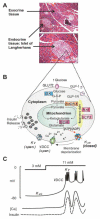Hyperinsulinism and diabetes: genetic dissection of beta cell metabolism-excitation coupling in mice
- PMID: 19945402
- PMCID: PMC3245718
- DOI: 10.1016/j.cmet.2009.10.011
Hyperinsulinism and diabetes: genetic dissection of beta cell metabolism-excitation coupling in mice
Abstract
The role of metabolism-excitation coupling in insulin secretion has long been apparent, but in recent years, in parallel with studies of human hyperinsulinism and diabetes, genetic manipulation of proteins involved in glucose transport, metabolism, and excitability in mice has brought the central importance of this pathway into sharp relief. We focus on these animal studies and how they provide important insights into not only metabolic and electrical regulation of insulin secretion, but also downstream consequences of alterations in this pathway and the etiology and treatment of insulin-secretion diseases in humans.
Figures

Similar articles
-
Statin treatment and new-onset diabetes: a review of proposed mechanisms.Metabolism. 2014 Jun;63(6):735-45. doi: 10.1016/j.metabol.2014.02.014. Epub 2014 Feb 25. Metabolism. 2014. PMID: 24641882 Review.
-
Genetic analysis of type-1 insulin-like growth factor receptor signaling through insulin receptor substrate-1 and -2 in pancreatic beta cells.J Biol Chem. 2010 Dec 24;285(52):41044-50. doi: 10.1074/jbc.M110.144790. Epub 2010 Oct 14. J Biol Chem. 2010. PMID: 20947509 Free PMC article.
-
Metabolic signaling in fuel-induced insulin secretion.Cell Metab. 2013 Aug 6;18(2):162-85. doi: 10.1016/j.cmet.2013.05.018. Epub 2013 Jun 20. Cell Metab. 2013. PMID: 23791483 Review.
-
Too much of a good thing: why it is bad to stimulate the beta cell to secrete insulin.Diabetologia. 2008 Apr;51(4):540-5. doi: 10.1007/s00125-008-0930-2. Epub 2008 Feb 2. Diabetologia. 2008. PMID: 18246324
-
Sulfonylurea receptor 1 mutations that cause opposite insulin secretion defects with chemical chaperone exposure.J Biol Chem. 2009 Mar 20;284(12):7951-9. doi: 10.1074/jbc.M807012200. Epub 2009 Jan 16. J Biol Chem. 2009. PMID: 19151370 Free PMC article.
Cited by
-
Cardiac specific ATP-sensitive K+ channel (KATP) overexpression results in embryonic lethality.J Mol Cell Cardiol. 2012 Sep;53(3):437-45. doi: 10.1016/j.yjmcc.2012.07.001. Epub 2012 Jul 13. J Mol Cell Cardiol. 2012. PMID: 22796573 Free PMC article.
-
Computational Identification of Novel Kir6 Channel Inhibitors.Front Pharmacol. 2019 May 24;10:549. doi: 10.3389/fphar.2019.00549. eCollection 2019. Front Pharmacol. 2019. PMID: 31178728 Free PMC article.
-
Role of KATP channels in glucose-regulated glucagon secretion and impaired counterregulation in type 2 diabetes.Cell Metab. 2013 Dec 3;18(6):871-82. doi: 10.1016/j.cmet.2013.10.014. Cell Metab. 2013. PMID: 24315372 Free PMC article.
-
Functional identification of islet cell types by electrophysiological fingerprinting.J R Soc Interface. 2017 Mar;14(128):20160999. doi: 10.1098/rsif.2016.0999. J R Soc Interface. 2017. PMID: 28275121 Free PMC article.
-
Modeling K,ATP--dependent excitability in pancreatic islets.Biophys J. 2014 Nov 4;107(9):2016-26. doi: 10.1016/j.bpj.2014.09.037. Biophys J. 2014. PMID: 25418087 Free PMC article.
References
-
- Aguilar-Bryan L, Bryan J, Nakazaki M. Of mice and men: K(ATP) channels and insulin secretion. Recent Prog Horm Res. 2001;56:47–68. - PubMed
-
- Araki E, Lipes MA, Patti ME, Bruning JC, Haag B, 3rd, Johnson RS, Kahn CR. Alternative pathway of insulin signalling in mice with targeted disruption of the IRS-1 gene. Nature. 1994;372:186–190. - PubMed
-
- Arkblad EL, Tuck S, Pestov NB, Dmitriev RI, Kostina MB, Stenvall J, Tranberg M, Rydstrom J. A Caenorhabditis elegans mutant lacking functional nicotinamide nucleotide transhydrogenase displays increased sensitivity to oxidative stress. Free Radical Biology & Medicine. 2005;38:1518–1525. - PubMed
-
- Arsenijevic D. Disruption of the uncoupling protein-2 gene in mice reveals a role in immunity and reactive oxygen species production.[see comment] Nat Genet. 2000;26:435–439. - PubMed
-
- Ashcroft FM. From molecule to malady. Nature. 2006;440:440–447. - PubMed
Publication types
MeSH terms
Substances
Grants and funding
LinkOut - more resources
Full Text Sources
Medical
Molecular Biology Databases

